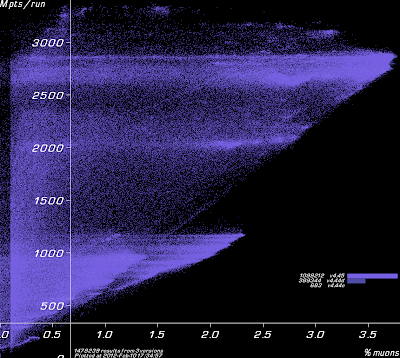With the retirement of both Linac900Ext10tc2 and Linac900Ext9X we’re moving on to Linac900Ext7Xc2 and Linac900Ext9Xc2. Both are development improvements of previous lattices, and attempt to work on phase handling, as well as investigate new designs without being side-tracked by jitter.
Just how big a problem jitter (the random noise that can mean almost identical designs can have a significantly different result, and add an element of fuzziness) can be shown in this graph from the Linac900Ext10d2_zoom lattice trial tested in late 2010.
 |
| v4.45 versus v4.44d click to enlarge. Credit: SJ Brooks |
 |
| Linac900Ext10tc2's yield/mpts graph showing results by client version |
- The 7 and 9 represent the number of blocks in the design.
- X shows that it’s got an extended maximum simulated time, just as the earlier “t” did. However, X *also* means that it requires 4.45 or later.
- The c2 refers to the method for generating the RF phase. It is in fact the inverse wave of the d2 attribute. Without either, it’s a single wave that starts with the c2 designs. However, as the 2 indicates, it contains TWO waves, rather than one.
 |
| RF Phase genome value in lattice design Credit S. Brooks |
Meanwhile, we’ll see how well these new lattices do. Already they’ve gone positive, and now that there’s clarity on the RF phase factor, we can expect things to be performing better than ever.
The official discussion thread on the new lattices is here


No comments:
Post a Comment